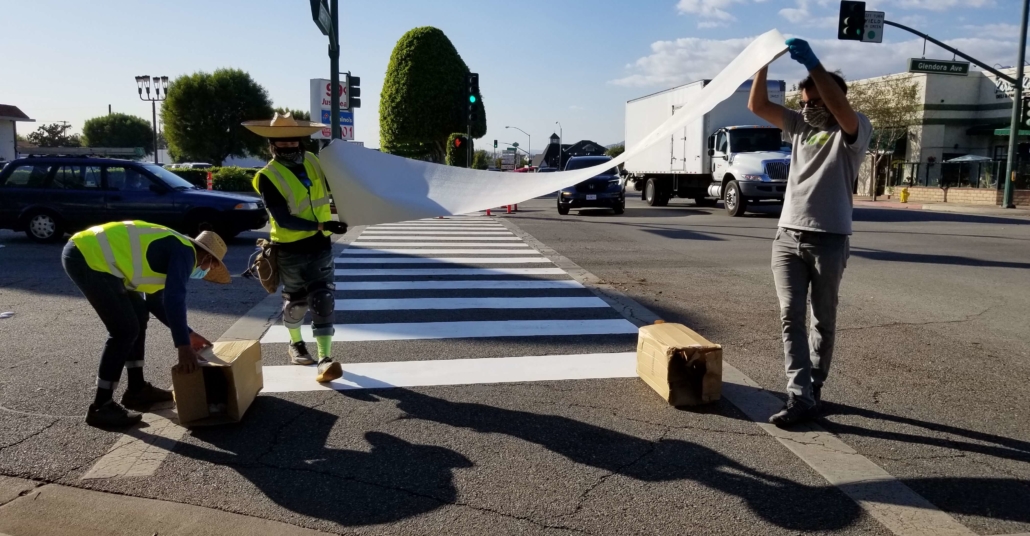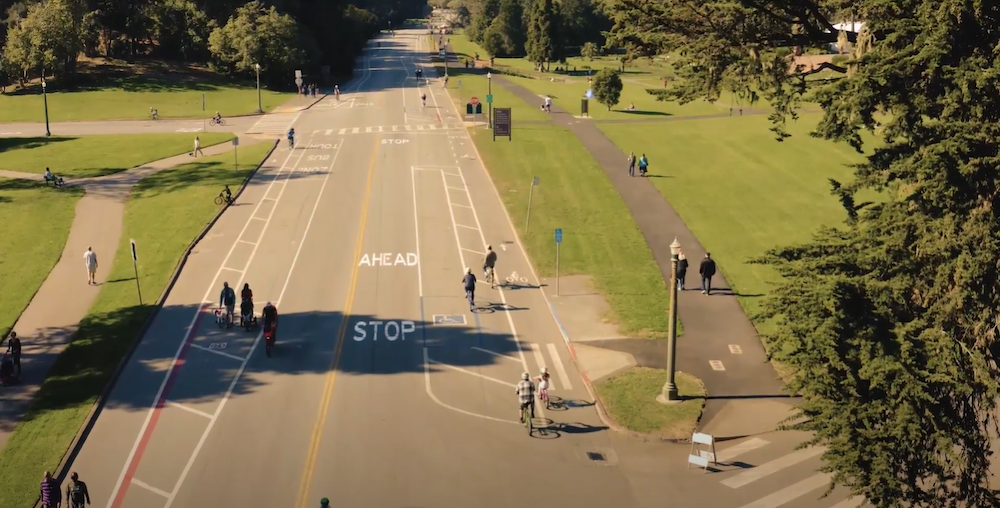CalBike’s Best and Worst of 2021
A completely unscientific look at the best and worst of California biking in 2021.
Let’s be honest: the competition for the worst in 2021 was fierce. We started the year with such high hopes. It had to be better than 2020, right? Nope. But there were many bright spots for biking in California, even in a crazy year like 2021. And, anyway, 2022 is bound to be a better year. Right? Right???
A bikeway grows in California
Whether fueled by the conversion of pandemic Slow Streets into permanent civic spaces or the fruit of many years of advocacy and local pressure, 2021 had a bumper crop of new bikeways. Here are some of the best, plus a couple of instances where planners let cars roll over their better judgment.
Best quick-build demo that should become permanent: Glendora Ave Complete Streets Demo

For most infrastructure projects, $46,000 would barely make a dent in the budget. But the city of Glendora and the San Gabriel Council of Governments used that amount to install quick-build improvements, including crosswalk striping and planters to create a buffer for separated bike lanes. Glendora plans to expand the project and make it permanent to improve access to a planned rail line extension, but the quick-build demo is helping people bike more safely right now. More of this, please. Read more in Streetsblog LA.
Best Slow Street that became permanent, thanks to quick-build: Doyle Street, Emeryville

Emeryville took advantage of pandemic Slow Streets and the availability of quick-build funding to exclude or restrict traffic on several blocks of Doyle Street. Quick-build allowed the city to quickly make changes to create a joyful, safe space, connecting playgrounds and an off-road bike path, where kids can zoom around on bikes and scooters and neighbors walk and ride. And they got design help from Mr. Barricade.
Best examples of persistence paying dividends—a 2-way tie!

Orange Avenue Family Bikeway
The Orange Avenue Family Bikeway is a grassroots project in an environmental justice community that will implement the San Diego region’s first Bike Boulevard network with traffic diverters. SANDAG leadership halted the project in 2016 to get a freeway-centric funding measure approved, but fortunately, it was saved by community leaders in 2017, approved in 2019, and fast-tracked in 2021.

Bike lanes on Broadway Avenue in Chula Vista
At four miles long in each direction, the bike lane on Broadway in Chula Vista is the longest continuous bike lane ever installed as a single project on a commercial corridor in San Diego County. It took more than eight years to get this project approved and completed. Shout out to City Heights Community Development Corporation for keeping the pressure on for Orange Avenue and Broadway.
Worst abuse of political power to cancel bike infrastructure: North Spring Street Bridge bike lanes, Los Angeles

Los Angeles City Council Members wield a lot of power, including, apparently, the ability to kill safety projects they don’t like. The villain in this story is Gil Cedillo, whose jurisdiction includes the mostly complete North Spring Street Bridge widening. The project should have included bike lanes, but those lanes were delayed, and it now appears that Cedillo has unilaterally canceled them. That change in project scope could affect the validity of the project’s CEQA review and force Los Angeles to return some of the funding that paid for it. Thanks to terrific advocacy from Streets for All and excellent reporting from Streetsblog LA shining a spotlight on Cedillo’s attempt to undermine safe streets.
Best Slow Street that should continue after the pandemic: JFK Drive, Golden Gate Park, San Francisco

Many of the Slow Streets programs created in 2020 continue as our pandemic life slogs on, but one of the best pandemic Open Streets is on the endangered list: JFK Drive, which cuts through the heart of San Francisco’s Golden Gate Park. The road had been closed to cars on weekends (a result of years of advocacy from the San Francisco Bicycle Coalition) and, thanks to pressure from advocates, the city made it car-free 24/7 during the pandemic. Since then, 36% more people have accessed the park, and there have been no accidents or injuries—a Vision Zero success. More than 70% of respondents supported keeping the roadway car-free in a city survey, and the San Francisco Chronicle Editorial Board came out in favor. Still, with powerful interests at museums in the park opposed, the future of this fantastic amenity is far from certain.
Worst concession to impatient car drivers: Great Highway, San Francisco

While San Francisco has preserved car-free JFK Drive (so far), the city bowed to drivers who couldn’t tolerate the inconvenience of taking a longer route and allowed car traffic back on the Great Highway along Ocean Beach, despite fierce resistance from biking and walking advocates. The road remains car-free on weekends, and the New York Times recently named it one of its 52 Places for a Changed World. The theme of the annual travel feature is climate adaptation this year, and the Times described the Great Highway as “pointing the way for post-pandemic urbanism.” We hope San Francisco will think better of its decision to trade a locus of recreation, car-free transportation, and joy for the convenience of the people who are literally driving climate change.
The best and worst of everything else
Worst attempt to thwart progress on bikeways through an electoral recall: Nithya Raman

Unfortunately, there was a lot to choose from with a wave of recalls initiated against elected officials in California. The only one that got enough signatures to make it to the voters was the unsuccessful attempt to topple Gavin Newsom from the governor’s seat. But we’d like to highlight the recall attempt against Los Angeles City Council Member Nithya Raman. CalBike heartily endorsed Raman, a transportation justice champion and bike-friendly leader. Her leadership promised to shake things up in the second-largest city in the U.S., so of course, she faced a campaign for her recall. Fortunately, the recall bid crashed and burned shortly after Newsom defeated his recall in September, showing the strong popular support for politicians who support bold changes in traffic safety as part of a progressive package.
Best investigation of biased policing against bicyclists: LA Times investigation of bike stops by sheriff’s deputies
The Los Angeles Times deserves major kudos for its in-depth look at data on bicycle stops and arrests by the Los Angeles Sheriff’s department. The Times analysis showed that police disproportionately stopped Latinos and targeted cyclists in poorer neighborhoods. Riders were stopped for minor infractions, largely as a pretext to search them for guns and drugs, but only a tiny percentage of stops turned up illegal items. The investigation has had results: the LA County Board of Supervisors is looking at decriminalizing minor bicycle infractions as a way to end biased policing. The Time’s reporting is another reminder that local newspapers are vital to our communities. Make a New Year’s resolution to subscribe to yours.
Best national conversation about safety: the national discussion of the insanity of jaywalking laws

The governor’s veto of the Freedom to Walk Act wasn’t a complete defeat for the cause. The campaign run by CalBike and our allies at California Walks and Los Angeles Walks, plus stellar efforts by Assemblymember Phil Ting, amplified and advanced a national conversation about the underhanded origins of jaywalking laws, which were designed to make city streets safe for cars, not people. Today, these laws are often used as a pretext for over-policing Black and brown people. The anticipated repeal of jaywalking laws even made it into one of the limericks on NPR’s Wait Wait Don’t Tell Me quiz show. The movement to reform how we police the use of our streets is just getting started, and the campaign to repeal this jaywalking law made great advances in the national conversation toward that goal.
Worst Charlie Brown kicking a football moment for active transportation: transportation budget delay
The e-bike affordability program shouldn’t have been the only positive budget development for biking in Sacramento in 2021. Faced with a historic budget surplus, legislators and the governor were poised to allocate an additional $500 million to the Active Transportation Program. This funding would have allowed about 80 excellent, shovel-ready bike and pedestrian projects to get the green light. But then, like Lucy pulling the football away from Charlie Brown, the promised ATP funding was snatched away when the governor and the legislature couldn’t agree on High-Speed Rail funding, which was to be part of the same funding package. However, the parties have resumed negotiations, and CalBike is asking for $2 billion for bikes. We’re counting on you, 2022, to give Charlie Brown the chance to finally kick the football out of the park and build more bikeways!
Best funding win to fight climate change: California’s e-bike subsidy program

Sacramento did come through for better biking in the budget, with $10 million for electric bicycle affordability. The program, which launches in July 2022, will offer vouchers to help people buy e-bikes. E-bikes make biking accessible to a broader range of people, and the voucher program will make e-bikes affordable for more Californians. We applaud the governor and legislature for funding this vital program (and a little pat on the back for ourselves, too, for advocacy that helped get it passed).
Best foot forward on regional planning: Hasan Ikhrata and SANDAG
The San Diego Association of Governments (SANDAG) has not historically been known for bike-friendly planning. But, with support from the association’s political leadership, Executive Director Hasan Ikhrata has been staking out a different path. In the face of possible funding shortfalls, Ikhrata committed to complete the regional bike plan’s Early Action Program, which includes the projects identified as a high priority. And SANDAG’s latest regional transportation plan represents a significant departure from past planning in the area. It has more emphasis on public transit and adopts the 10 Transit Lifelines developed by San Diego Transportation Equity Working Group. If implemented, the plan might even bring the region into compliance with its state-mandated greenhouse gas reduction goals.
Worst way to prove that traffic jams are a safety measure: bike/ped crashes went up despite traffic going down during the pandemic

In 2021, the data came in: while most of us holed up in our houses in 2020, the smaller number of cars on the roadways managed to kill more pedestrians than the year before. Remember this the next time a traffic engineer or planner tries to justify a road widening by saying it will make it safer. Driving went up in 2021 but traffic was still 22% below pre-pandemic levels. And, while the final crash data for 2021 isn’t in, it’s likely that car crash fatalities for people outside cars will be high once again.
Worst global pandemic that Will. Not. Go. Away!
You know the answer to this one. Mask up, get boosted, stay safe, and let’s hope for better days in 2022!
Did we miss one of your best or worst? Tweet your 2021 California bicycle advocacy hits and misses @calbike.


